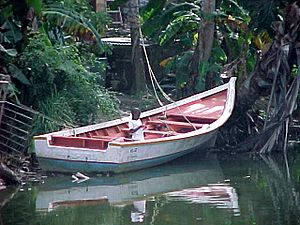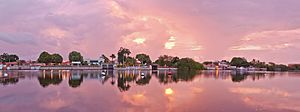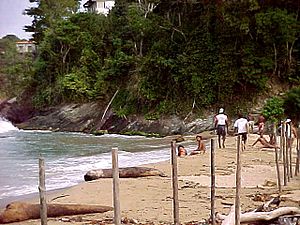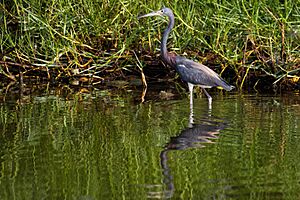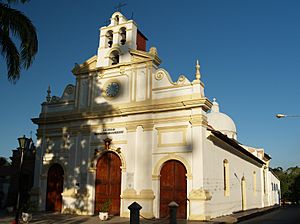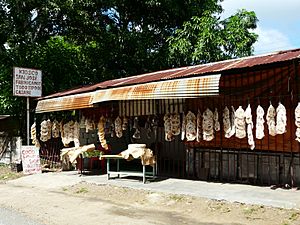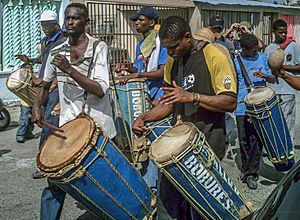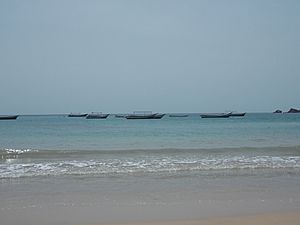Barlovento, Venezuela facts for kids
Barlovento is a special region in Miranda state, Venezuela. Long ago, during the time of Spanish colonization of the Americas, Barlovento became known for its large farms called haciendas. These farms grew cacao plants, which are used to make chocolate! People from parts of Africa, like the Republic of the Congo, Democratic Republic of the Congo, Angola, and the Yoruba lands, were brought here to work on these farms.
Over time, the cultures of the African and Spanish people mixed together. This led to a unique celebration called "drum dancing," which is very popular in Barlovento. You can often see this lively dance during the feast of San Juan. Other fun events include the Entierro de la Sardina (Burial of the Sardine) and Day of the Dead. It's interesting how some Catholic saints in Barlovento have also come to represent traditional African gods.
Contents
What "Barlovento" Means
The name "Barlovento" comes from a Spanish word that means "windward." This describes how the wind blows in the region. It brings heavy rain from the south, then travels to the coast, crosses the Caribbean Sea and the Atlantic Ocean, and even brings rain to the Canary Islands.
Where Barlovento Is Located
Barlovento is found along the coast of Venezuela, which is in the northern part of South America.
It's located between 10° and 11° north latitude and 65° and 67° west longitude. The big city of Caracas is about 100 kilometres (62 mi) to the east.
To the north, Barlovento touches the Caribbean Sea. To the east, it also meets the Caribbean Sea and Anzoátegui State. To the south, you'll find the Serranía del Interior mountains, Anzoátegui state, and Guárico state. To the west, it's close to Caracas, another part of the Cordillera de la Costa mountains, Vargas State, and other towns in Miranda State.
Barlovento's Geography
Barlovento covers a large area of about 4,647 square kilometers. This means it makes up more than half (58 percent) of the entire Miranda state. The land in Barlovento changes a lot, from the mountains in Caucagua to the beautiful beaches of Higuerote and Río Chico.
The flat area of Barlovento, called the Plain of Barlovento, is located between the Valles del Tuy to the east and Anzoátegui state to the west. To the south is Guárico state. The northern part of this area has a lot of limestone. This land was formed by dirt and rocks carried by rivers flowing from the Serranía del Interior mountains.
In the slopes of the Serranía del Interior, there are many cool caves and caverns. One famous example is La Tapa de Cambrai near Birongo. It was first found by a hunter in 1934.
Many rivers flow through the Plain of Barlovento. Over time, these rivers have left behind sediment, which has helped form oil deposits in some areas.
A Look at History
Between the years 1576 and 1810, about 100,000 African people were brought to Venezuela as part of the slave trade. In Barlovento, these enslaved people were forced to work on cocoa farms. There were about 4,000 of these farms! By 1924, the Barlovento and Paria regions grew a huge amount of Venezuela's cocoa, about 80% of the 20,000 tons exported. Some enslaved people managed to escape and created small, secret communities in Barlovento called cumbes.
Towns in Barlovento
Some of the towns you can find in Barlovento are Caucagua, Capaya, Río Chico, El Guapo, Higuerote, Panaquire, Tapipa, El Clavo, Curiepe, Birongo, Tacarigua de Brión, San José de Barlovento, and Cúpira.
Acevedo is the biggest town in the Barlovento region. It has about 150,281 people. Andrés Bello has about 59,342 people and is growing quickly. Brión Municipality is growing the fastest, with an estimated population of 78,940. Buroz has about 38,945 people and has kept its old colonial houses and narrow streets. Páez is the second fastest-growing town with 62,723 people. Pedro Gual, the easternmost town, has about 42,831 people.
Economy of Barlovento
Barlovento used to be known as the "Granary of Caracas" because it produced so much food. Farmers still grow crops like cacao, beans, and plantains. The area has also become popular for tourism. Many people who live in Barlovento travel to Caracas for work using the Gran Mariscal de Ayacucho highway.
Roads and Travel
Barlovento has a good network of paved roads. These include the Bicentenario Intercommunal Avenue, the San José-Río Chico road, and the Troncal ninth highway. This highway passes through several towns like Andrés Bello, Páez, Brión, Buroz, and Pedro Gual.
Religion in Barlovento
Since the 1500s, the people of Barlovento, both farm owners and African enslaved people, really loved the feast of San Juan. They would celebrate with lots of music and dancing. Even though a bishop named Mariano Marti didn't like these "ridiculous and earthly diversions" when he visited in 1784, the festival kept getting more and more popular. The date of the feast, June 25, was special because it was when the cocoa beans were harvested, the rainy season began, and it was around the summer solstice.
Culture of Barlovento
Delicious Food
The food in Barlovento shows off the different cultures that have come together there. It uses local ingredients like grains, root vegetables, bananas, fish, seafood, and a small animal called lapa.
One of the oldest dishes is Cafunga. It comes from African culture and is a banana muffin made with cassava, coconut, papelón (a type of brown sugar), and anise. Other popular foods include Tropezón, which is white beans cooked with pork skins; "Soup of Massey," a white soup with sardines and garlic; and Bañao, which is cooked ripe banana with a caramel sauce made from papelón, anise, and cloves.
The town of Tacarigua de la Laguna is especially famous for its delicious roast Lebranche mullet fish.
Handmade Crafts
The people of Barlovento are very artistic! They make sculptures, small models, and trinkets using balsa wood, other local woods, and coconuts. You can often see these crafts displayed and sold by the sides of the roads. For example, in the village of Yagura, you might see balsa wood models of airplanes and helicopters. In Gamelotal, a sculptor named Adam Expedito López creates amazing things from wood and coconuts, like tall poles, portraits of Bolívar, and coconuts carved with the faces of old caciques (chiefs). In Higuerote, artists make wooden birds that live in the canals and lagoons of Barlovento, such as coro-coras and herons.
People also make hammocks. In Barlovento, especially in Curiepe, skilled artisans create drums for African dancing. These include the curbata, the mina, and the culepuya. The culepuya itself has three different types: the prima, cruzao, and pujao. They also make furrucos for playing Christmas music.
African Drum Dancing
Playing African drums and dancing to their rhythms, known as "drum dancing," is a very important part of Barlovento's culture. This is especially true on June 24th each year, which is the feast day of San Juan (John the Baptist) in the Catholic Church.
Barlovento is known as the region in Venezuela where African culture has had a very strong influence. This is because many African enslaved people were brought to this area, particularly to the town of Curiepe.
Fun Places to Visit
Barlovento has many fun places to visit, including beautiful beaches, private clubs, and large places to stay. Some of its hotels are the AB Beach Hotel, Barlovento Hotel, Campomar, Las Olas Resort, and Aguamarina. Its popular beaches include Los Totumos, Paparo, La Cangrejera, Chirere, Puerto Francés, Machurucuto, and Playa Pintada.
See also
 In Spanish: Llanura de Barlovento para niños
In Spanish: Llanura de Barlovento para niños
- Gallegos R. Pobre Negros Espasa-Calpe, Argentina, 1970.
- Sojo J. P. Nochebuenos Negra (1943)


